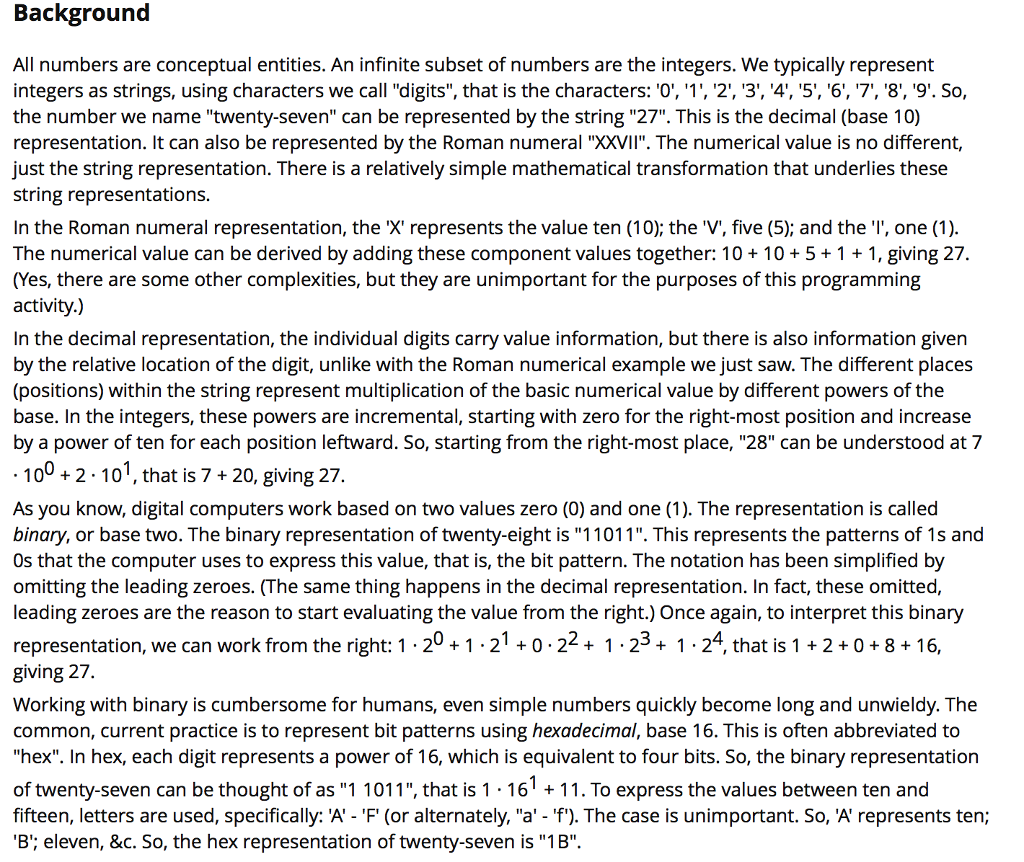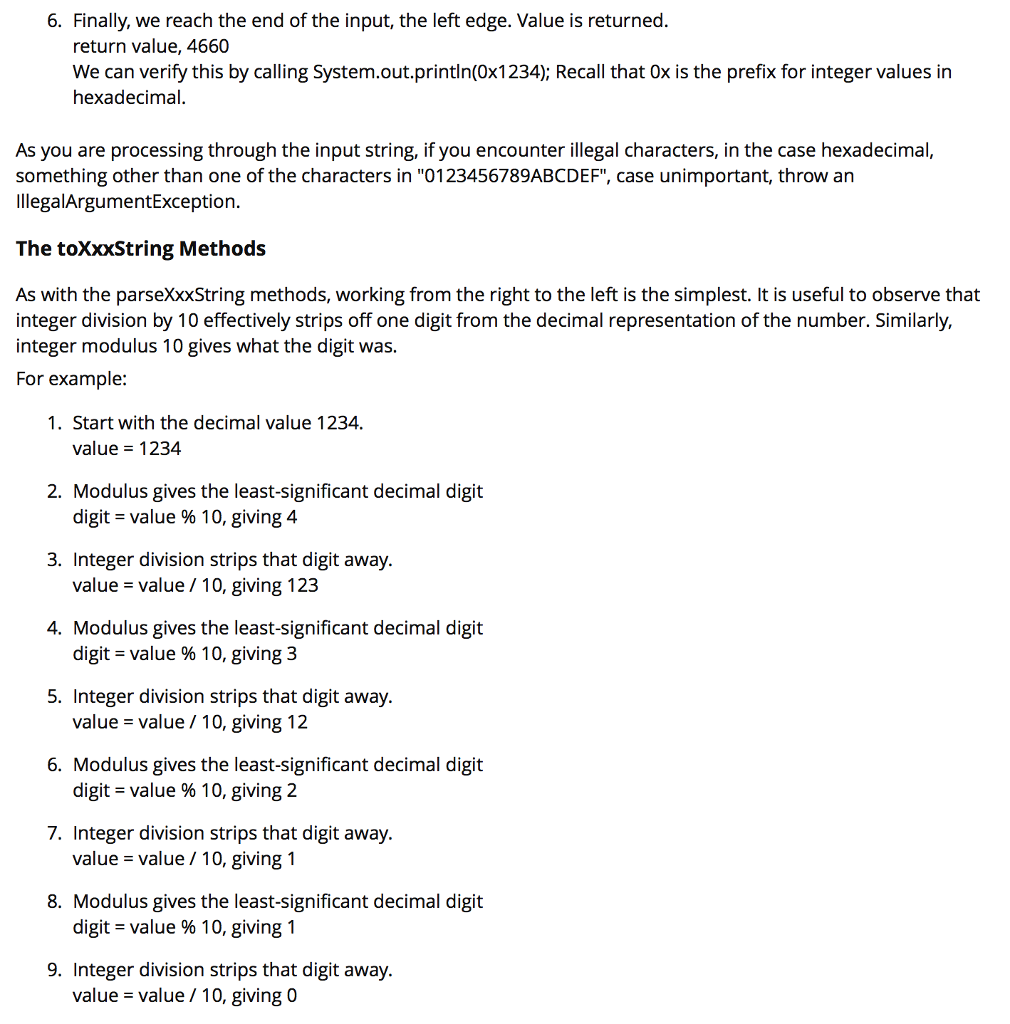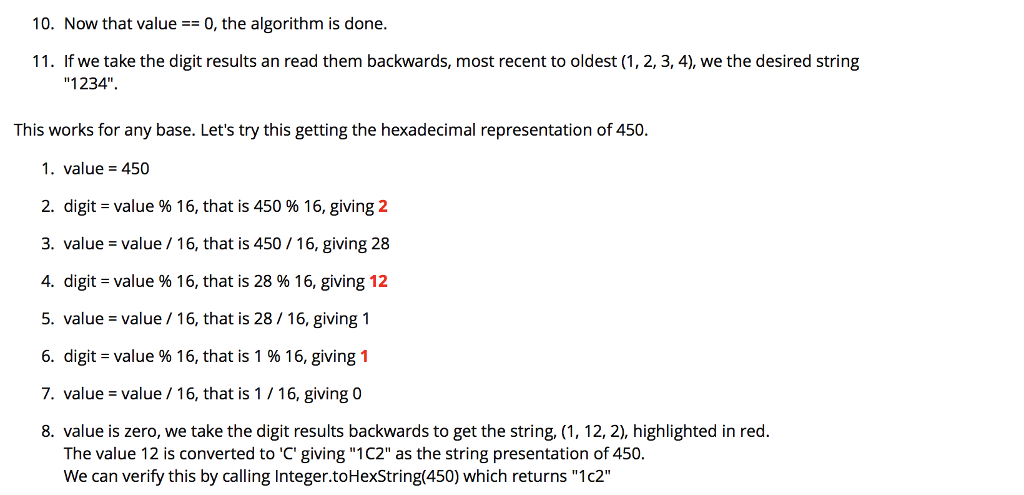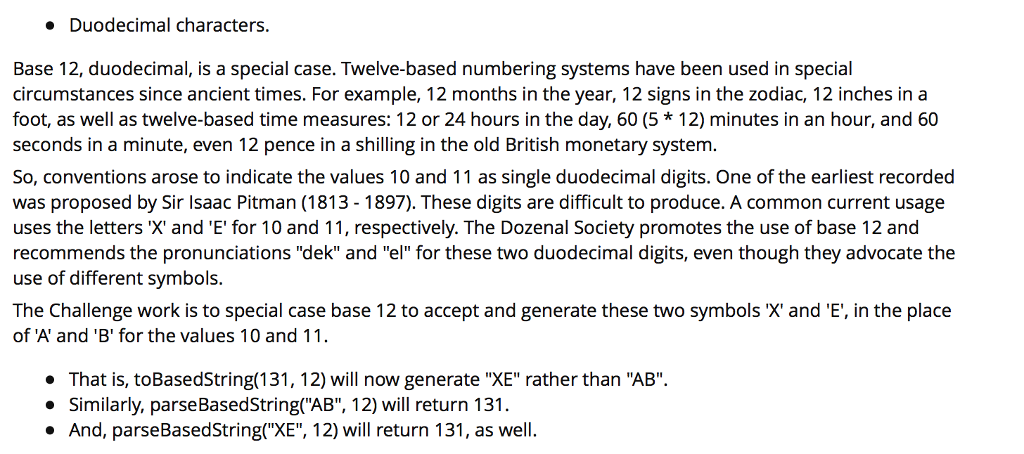Answered step by step
Verified Expert Solution
Question
1 Approved Answer
BELOW IS STARTER CODE (BASE CONVERSION) The other, Is below this code. BaseConversion is an interface for you to implement. You shall implement this interface.
BELOW IS STARTER CODE (BASE CONVERSION) The other, Is below this code. BaseConversion is an interface for you to implement. You shall implement this interface. Name your implementation BaseConverter.java. /** * Interface for the Programming Assignment: Base Converter */ public interface BaseConversion { /** * Convert from a decimal (base 10) string representation * to an int value * @param s The decimal (base 10) representation * @return The corresponding numerical value */ public int parseDecimalString(String s); /** * Convert from a hexadecimal (base 16) string representation * to an int value * @param s The hexadecimal (base 16) representation * @return The corresponding numerical value */ public int parseHexString(String s); /** * Convert from a binary (base 2) string representation * to an int value * @param s The binary (base 2) representation * @return The corresponding numerical value */ public int parseBinaryString(String s); /** * Generate the decimal (base 10) representation of an * integer value * @param num The integer value to represent * @return The decimal (base 10) representation */ public String toDecimalString(int num); /** * Generate the hexadecimal (base 16) representation of an * integer value * @param num The integer value to represent * @return The hexadecimal (base 16) representation */ public String toHexString(int num); /** * Generate the binary (base 2) representation of an * integer value * @param num The integer value to represent * @return The binary (base 2) representation */ public String toBinaryString(int num); /** * Convert from a string representation of an int value * in a given base to its numerical value * @param s The string representation * @param base The numerical base for the representation * @return The corresponding numerical value */ public int parseBasedString(String s, int base); /** * Generate the string representation of an * integer value in a given base * @param num The integer value to represent * @param base The base for the representation * @return The based representation */ public String toBasedString(int num, int base); }
BELOW THIS IS THE BEGINNING OF THE SECOND STARTER CODE.(BASECONVERTERUI)
BaseConverterUI is a simple GUI you can use to test your implementation.
public class BaseConverterUI implements java.awt.event.ActionListener { private javax.swing.JTextField input; private javax.swing.JLabel output; private javax.swing.JRadioButton toDecimal; private javax.swing.JRadioButton toHex; private javax.swing.JRadioButton toBinary; private javax.swing.JRadioButton toBased; private javax.swing.JRadioButton fromDecimal; private javax.swing.JRadioButton fromHex; private javax.swing.JRadioButton fromBinary; private javax.swing.JRadioButton fromBased; private javax.swing.JSpinner fromBase; private javax.swing.JSpinner toBase; private javax.swing.JButton convert; private java.awt.Font display; private BaseConversion converter; public BaseConverterUI() { // instantiate the converter converter = new BaseConverter(); // create the GUI javax.swing.JFrame win = new javax.swing.JFrame("Base Converter"); win.setDefaultCloseOperation(javax.swing.JFrame.DISPOSE_ON_CLOSE); win.setLocation(25, 25); javax.swing.JPanel frame = new javax.swing.JPanel(); win.add(frame); javax.swing.Box contents = javax.swing.Box.createVerticalBox(); frame.add(contents); display = new java.awt.Font("Helvetica", java.awt.Font.BOLD, 24); // source (input) input = new javax.swing.JTextField("100", 10); input.setFont(display); input.setHorizontalAlignment(javax.swing.JTextField.CENTER); javax.swing.JPanel inputPanel = new javax.swing.JPanel(); inputPanel.add(input); javax.swing.border.TitledBorder inputTitle; inputTitle = javax.swing.BorderFactory.createTitledBorder("Source String"); inputPanel.setBorder(inputTitle); // target (output) output = new javax.swing.JLabel(" "); output.setFont(display); javax.swing.JPanel outputPanel = new javax.swing.JPanel(); outputPanel.add(output); javax.swing.border.TitledBorder outputTitle; outputTitle = javax.swing.BorderFactory.createTitledBorder("Output String"); outputPanel.setBorder(outputTitle); // go convert = new javax.swing.JButton("Convert"); convert.addActionListener(this); javax.swing.JPanel buttonPanel = new javax.swing.JPanel(); buttonPanel.add(convert); // box for base selection javax.swing.Box basePanel = javax.swing.Box.createHorizontalBox(); // select source base fromDecimal = new javax.swing.JRadioButton("decimal (base 10)"); fromHex = new javax.swing.JRadioButton("hexadecimal (base 16)"); fromBinary = new javax.swing.JRadioButton("binary (base 2)"); fromBased = new javax.swing.JRadioButton("select base"); javax.swing.SpinnerModel fromModel = new javax.swing.SpinnerNumberModel(10, 2, 36, 1); fromBase = new javax.swing.JSpinner(fromModel); javax.swing.ButtonGroup fromGroup = new javax.swing.ButtonGroup(); fromGroup.add(fromDecimal); fromGroup.add(fromHex); fromGroup.add(fromBinary); fromGroup.add(fromBased); fromDecimal.setSelected(true); fromDecimal.addActionListener(this); fromHex.addActionListener(this); fromBinary.addActionListener(this); fromBased.addActionListener(this); javax.swing.JPanel fromPanel = new javax.swing.JPanel(new java.awt.GridLayout(4,1)); fromPanel.add(fromDecimal); fromPanel.add(fromHex); fromPanel.add(fromBinary); javax.swing.Box fromSelect = javax.swing.Box.createHorizontalBox(); fromSelect.add(fromBased); fromSelect.add(fromBase); fromBase.setEnabled(false); fromPanel.add(fromSelect); javax.swing.border.TitledBorder fromTitle; fromTitle = javax.swing.BorderFactory.createTitledBorder("Source Base"); fromPanel.setBorder(fromTitle); basePanel.add(fromPanel); // select target base toDecimal = new javax.swing.JRadioButton("decimal (base 10)"); toHex = new javax.swing.JRadioButton("hexadecimal (base 16)"); toBinary = new javax.swing.JRadioButton("binary (base 2)"); toBased = new javax.swing.JRadioButton("select base"); javax.swing.SpinnerModel toModel = new javax.swing.SpinnerNumberModel(16, 2, 36, 1); toBase = new javax.swing.JSpinner(toModel); javax.swing.ButtonGroup toGroup = new javax.swing.ButtonGroup(); toGroup.add(toDecimal); toGroup.add(toHex); toGroup.add(toBinary); toGroup.add(toBased); toHex.setSelected(true); toBase.setValue(16); toDecimal.addActionListener(this); toHex.addActionListener(this); toBinary.addActionListener(this); toBased.addActionListener(this); javax.swing.JPanel toPanel = new javax.swing.JPanel(new java.awt.GridLayout(4,1)); toPanel.add(toDecimal); toPanel.add(toHex); toPanel.add(toBinary); javax.swing.Box toSelect = javax.swing.Box.createHorizontalBox(); toSelect.add(toBased); toSelect.add(toBase); toBase.setEnabled(false); toPanel.add(toSelect); javax.swing.border.TitledBorder toTitle; toTitle = javax.swing.BorderFactory.createTitledBorder("Target Base"); toPanel.setBorder(toTitle); basePanel.add(toPanel); // assemble window contents.add(inputPanel); contents.add(basePanel); contents.add(outputPanel); contents.add(buttonPanel); win.setVisible(true); win.pack(); } public void actionPerformed(java.awt.event.ActionEvent e) { Object source = e.getSource(); if(source == toDecimal || source == toHex || source == toBinary) { toBase.setEnabled(false); } else if(source == toBased) { toBase.setEnabled(true); } else if(source == fromDecimal || source == fromHex || source == fromBinary) { fromBase.setEnabled(false); } else if(source == fromBased) { fromBase.setEnabled(true); } else if(source == convert) { try { int value = getInput(); output.setText(getOutput(value)); output.setFont(display); output.setForeground(java.awt.Color.black); input.selectAll(); input.requestFocus(); } catch(UnsupportedOperationException ex) { output.setText("Unsupported Operation"); output.setFont(null); output.setForeground(java.awt.Color.red); } catch(Exception ex) { output.setText("Some exception occurred"); output.setFont(null); output.setForeground(java.awt.Color.red); } } else { throw new IllegalStateException("No input base selected"); } } private int getInput() { String source = input.getText(); if(fromDecimal.isSelected()) { return converter.parseDecimalString(source); } else if(fromHex.isSelected()) { return converter.parseHexString(source); } else if(fromBinary.isSelected()) { return converter.parseBinaryString(source); } else if(fromBased.isSelected()) { int base; base = Integer.parseInt(fromBase.getValue().toString()); return converter.parseBasedString(source, base); } else { throw new IllegalStateException("We should never get here"); } } private String getOutput(int value) { if(toDecimal.isSelected()) { return converter.toDecimalString(value); } else if(toHex.isSelected()) { return converter.toHexString(value); } else if(toBinary.isSelected()) { return converter.toBinaryString(value); } else if(toBased.isSelected()) { int base; base = Integer.parseInt(toBase.getValue().toString()); return converter.toBasedString(value, base); } else { throw new IllegalStateException("We should never get here"); } } public static void main(String[] args) { new BaseConverterUI(); } } 
Provide "real" implementations for the following methods of BaseConversion:



 Please be sure to include the duodecimals and add implementations for parseBasedString and toBasedString for base values! Thanks in advance
Please be sure to include the duodecimals and add implementations for parseBasedString and toBasedString for base values! Thanks in advance
* parseDecimalString * parseHexString * parseBinaryString * toDecimalString * toHexString * toBinaryString The algorithms are described below. Do not use any of the methods of java.lang.Integer. The other two methods: parseBasedString and toBasedString, shall throw an UnsupportedOperationException. The parseXxxString Methods The implementation of the parseXxxString methods can be simplified by working through the string from right to left, as was shown in the examples given above. This precludes the need to determine the length of the input string and then calculate some power of the base. As you process through the input string from right to left, the power of the base can simply be calculated from the current power times the base. Here is an example of parseHexString for the input "1234". 1. We start with the value being zero (0) 2. Then, working from the right end of the string, the power is 16 or 1 and the coefficient (abbreviated to coeff) is '4'. This is added to the value: power 1 coeff 4 value = value + coeff * power, that is 0 + 4 * 1, or 4 3. Working toward the left, the power is the previous value, 1, times the base, 16. The coefficient is the next digit, '3'. power *base coeff 3 value value + coeff * power, that is 4+3 * 16, or 52 4. Continuing to the left, power is updated again, and the coeff is the next digit, 2. power *- base coeff 2 value value +coeff * power, that is 52 + 2 * 236, or 564 5. Continuing to the left, power is updated again, and the coeff is the next digit,12. power *= base coeff= 1 value value + coeff * power, that is 564 + 1 * 4096, or 4660 Background All numbers are conceptual entities. An infinite subset of numbers are the integers. We typically represent integers as strings, using characters we call "digits", that is the characters: '0', '1', '2', '3', '4,'5', '6', 7, '8', '9'. So, the number we name "twenty-seven" can be represented by the string "27". This is the decimal (base 10) representation. It can also be represented by the Roman numeral "XxVil". The numerical value is no different, just the string representation. There is a relatively simple mathematical transformation that underlies these string representations. In the Roman numeral representation, the 'X' represents the value ten (10); the 'V, five (5); and the'l', one (1) The numerical value can be derived by adding these component values together: 10+ 10+5+1+1, giving 27. (Yes, there are some other complexities, but they are unimportant for the purposes of this programming activity.) In the decimal representation, the individual digits carry value information, but there is also information given by the relative location of the digit, unlike with the Roman numerical example we just saw. The different places (positions) within the string represent multiplication of the basic numerical value by different powers of the base. In the integers, these powers are incremental, starting with zero for the right-most position and increase by a power of ten for each position leftward. So, starting from the right-most place, "28" can be understood at 7 0 10+2.10 ', that is 7+ 20, giving 27. As you know, digital computers work based on two values zero (0) and one (1). The representation is called binary, or base two. The binary representation of twenty-eight is "11011". This represents the patterns of 1s and 0s that the computer uses to express this value, that is, the bit pattern. The notation has been simplified by omitting the leading zeroes. (The same thing happens in the decimal representation. In fact, these omitted, leading zeroes are the reason to start evaluating the value from the right.) Once again, to interpret this binary representation, we can work from the right: 1 . 2o + 1 2| + 0 . 24 1 29 + 1 . 24, that is 1 + 2 + 0 + 8 + 16, giving 27. Working with binary is cumbersome for humans, even simple numbers quickly become long and unwieldy. The common, current practice is to represent bit patterns using hexadecimal, base 16. This is often abbreviated to "hex". In hex, each digit represents a power of 16, which is equivalent to four bits. So, the binary representation of twenty-seven can be thought of as "1 1011", that is 1.16 +11. To express the values between ten and fifteen, letters are used, specifically: A' - 'F (or alternately, "a' - 'f). The case is unimportant. So, 'A' represents ten; 'B'; eleven, &c. So, the hex representation of twenty-seven is "1B". 0 2 3 Add implementations for parseBasedString and toBasedString for base values between 2 and 36, inclusive Use the letters 'A' through 'Z' (or 'a' through 'z, case does not matter) to represent digits beyond 9. In the implementation for parseBasedString, work through the input string from left to right. Note the following features of polynomials: ax4 bx3x2dxe ((0 a) *xb)*x +c)*x+ d) * x+ e Use the call stack to "reverse" the digit values calculated by the toBasedString methods. Note that these two methods, parseBasedString and toBasedString, process through the data in the opposite direction than the implementations used in the Minimal version. So, while you could reimplement the six methods of the Minimal version in terms of these two new methods, it is much easier (safer) to leave them alone. 6. Finally, we reach the end of the input, the left edge. Value is returned return value, 4660 We can verify this by calling System.out.println(0x1234); Recall that 0x is the prefix for integer values in hexadecimal. As you are processing through the input string, if you encounter illegal characters, in the case hexadecimal, something other than one of the characters in "0123456789ABCDEF", case unimportant, throw an IllegalArgumentException. The toXxxString Methods As with the parseXxxString methods, working from the right to the left is the simplest. It is useful to observe that integer division by 10 effectively strips off one digit from the decimal representation of the number. Similarly, integer modulus 10 gives what the digit was. For example: 1. Start with the decimal value 1234 value - 1234 2. Modulus gives the least-significant decimal digit digit-value % 10, giving 4 3. Integer division strips that digit away. value value /10, giving 123 4. Modulus gives the least-significant decimal digit digit-value % 10, giving 3 5. Integer division strips that digit away. value value / 10, giving 12 6. Modulus gives the least-significant decimal digit digit value % 10, giving 2 7. Integer division strips that digit away value value 10, giving 1 8. Modulus gives the least-significant decimal digit digit-value % 10, giving 1 9. Integer division strips that digit away. value -value 10, giving 0 10. Now that value0, the algorithm is done 11. If we take the digit results an read them backwards, most recent to oldest (1, 2, 3, 4), we the desired string "1234" This works for any base. Let's try this getting the hexadecimal representation of 450 1. value 450 2. digits value % 16, that is 450 % 16, giving 2 3. value value 16, that is 450/16, giving 28 4. digits value 96 16, that is 28 % 16, giving 12 5. value value /16, that is 28/16, giving 1 6, digits value 96 16, that is 1 % 16, giving 1 7. value value/16, that is 1/16, giving 0 8. value is zero, we take the digit results backwards to get the string, (1, 12, 2), highlighted in red. The value 12 is converted to 'C giving "1C2" as the string presentation of 450 We can verify this by calling Integer.toHexString(450) which returns "1c2" Duodecimal characters. Base 12, duodecimal, is a special case. Twelve-based numbering systems have been used in special circumstances since ancient times. For example, 12 months in the year, 12 signs in the zodiac, 12 inches in a foot, as well as twelve-based time measures: 12 or 24 hours in the day, 60 (5 * 12) minutes in an hour, and 60 seconds in a minute, even 12 pence in a shilling in the old British monetary system So, conventions arose to indicate the values 10 and 11 as single duodecimal digits. One of the earliest recorded was proposed by Sir Isaac Pitman (1813 - 1897). These digits are difficult to produce. A common current usage uses the letters X' and 'E' for 10 and 11, respectively. The Dozenal Society promotes the use of base 12 and recommends the pronunciations "dek" and "el" for these two duodecimal digits, even though they advocate the use of different symbols. The Challenge work is to special case base 12 to accept and generate these two symbols 'X' and 'E, in the place of 'A' and 'B' for the values 10 and 11 . That is, toBasedString(131, 12) will now generate "XE" rather than "AB'". . Similarly, parseBasedString("AB", 12) will return 131 And, parseBasedString("XE", 12) will return 131, as well * parseDecimalString * parseHexString * parseBinaryString * toDecimalString * toHexString * toBinaryString The algorithms are described below. Do not use any of the methods of java.lang.Integer. The other two methods: parseBasedString and toBasedString, shall throw an UnsupportedOperationException. The parseXxxString Methods The implementation of the parseXxxString methods can be simplified by working through the string from right to left, as was shown in the examples given above. This precludes the need to determine the length of the input string and then calculate some power of the base. As you process through the input string from right to left, the power of the base can simply be calculated from the current power times the base. Here is an example of parseHexString for the input "1234". 1. We start with the value being zero (0) 2. Then, working from the right end of the string, the power is 16 or 1 and the coefficient (abbreviated to coeff) is '4'. This is added to the value: power 1 coeff 4 value = value + coeff * power, that is 0 + 4 * 1, or 4 3. Working toward the left, the power is the previous value, 1, times the base, 16. The coefficient is the next digit, '3'. power *base coeff 3 value value + coeff * power, that is 4+3 * 16, or 52 4. Continuing to the left, power is updated again, and the coeff is the next digit, 2. power *- base coeff 2 value value +coeff * power, that is 52 + 2 * 236, or 564 5. Continuing to the left, power is updated again, and the coeff is the next digit,12. power *= base coeff= 1 value value + coeff * power, that is 564 + 1 * 4096, or 4660 Background All numbers are conceptual entities. An infinite subset of numbers are the integers. We typically represent integers as strings, using characters we call "digits", that is the characters: '0', '1', '2', '3', '4,'5', '6', 7, '8', '9'. So, the number we name "twenty-seven" can be represented by the string "27". This is the decimal (base 10) representation. It can also be represented by the Roman numeral "XxVil". The numerical value is no different, just the string representation. There is a relatively simple mathematical transformation that underlies these string representations. In the Roman numeral representation, the 'X' represents the value ten (10); the 'V, five (5); and the'l', one (1) The numerical value can be derived by adding these component values together: 10+ 10+5+1+1, giving 27. (Yes, there are some other complexities, but they are unimportant for the purposes of this programming activity.) In the decimal representation, the individual digits carry value information, but there is also information given by the relative location of the digit, unlike with the Roman numerical example we just saw. The different places (positions) within the string represent multiplication of the basic numerical value by different powers of the base. In the integers, these powers are incremental, starting with zero for the right-most position and increase by a power of ten for each position leftward. So, starting from the right-most place, "28" can be understood at 7 0 10+2.10 ', that is 7+ 20, giving 27. As you know, digital computers work based on two values zero (0) and one (1). The representation is called binary, or base two. The binary representation of twenty-eight is "11011". This represents the patterns of 1s and 0s that the computer uses to express this value, that is, the bit pattern. The notation has been simplified by omitting the leading zeroes. (The same thing happens in the decimal representation. In fact, these omitted, leading zeroes are the reason to start evaluating the value from the right.) Once again, to interpret this binary representation, we can work from the right: 1 . 2o + 1 2| + 0 . 24 1 29 + 1 . 24, that is 1 + 2 + 0 + 8 + 16, giving 27. Working with binary is cumbersome for humans, even simple numbers quickly become long and unwieldy. The common, current practice is to represent bit patterns using hexadecimal, base 16. This is often abbreviated to "hex". In hex, each digit represents a power of 16, which is equivalent to four bits. So, the binary representation of twenty-seven can be thought of as "1 1011", that is 1.16 +11. To express the values between ten and fifteen, letters are used, specifically: A' - 'F (or alternately, "a' - 'f). The case is unimportant. So, 'A' represents ten; 'B'; eleven, &c. So, the hex representation of twenty-seven is "1B". 0 2 3 Add implementations for parseBasedString and toBasedString for base values between 2 and 36, inclusive Use the letters 'A' through 'Z' (or 'a' through 'z, case does not matter) to represent digits beyond 9. In the implementation for parseBasedString, work through the input string from left to right. Note the following features of polynomials: ax4 bx3x2dxe ((0 a) *xb)*x +c)*x+ d) * x+ e Use the call stack to "reverse" the digit values calculated by the toBasedString methods. Note that these two methods, parseBasedString and toBasedString, process through the data in the opposite direction than the implementations used in the Minimal version. So, while you could reimplement the six methods of the Minimal version in terms of these two new methods, it is much easier (safer) to leave them alone. 6. Finally, we reach the end of the input, the left edge. Value is returned return value, 4660 We can verify this by calling System.out.println(0x1234); Recall that 0x is the prefix for integer values in hexadecimal. As you are processing through the input string, if you encounter illegal characters, in the case hexadecimal, something other than one of the characters in "0123456789ABCDEF", case unimportant, throw an IllegalArgumentException. The toXxxString Methods As with the parseXxxString methods, working from the right to the left is the simplest. It is useful to observe that integer division by 10 effectively strips off one digit from the decimal representation of the number. Similarly, integer modulus 10 gives what the digit was. For example: 1. Start with the decimal value 1234 value - 1234 2. Modulus gives the least-significant decimal digit digit-value % 10, giving 4 3. Integer division strips that digit away. value value /10, giving 123 4. Modulus gives the least-significant decimal digit digit-value % 10, giving 3 5. Integer division strips that digit away. value value / 10, giving 12 6. Modulus gives the least-significant decimal digit digit value % 10, giving 2 7. Integer division strips that digit away value value 10, giving 1 8. Modulus gives the least-significant decimal digit digit-value % 10, giving 1 9. Integer division strips that digit away. value -value 10, giving 0 10. Now that value0, the algorithm is done 11. If we take the digit results an read them backwards, most recent to oldest (1, 2, 3, 4), we the desired string "1234" This works for any base. Let's try this getting the hexadecimal representation of 450 1. value 450 2. digits value % 16, that is 450 % 16, giving 2 3. value value 16, that is 450/16, giving 28 4. digits value 96 16, that is 28 % 16, giving 12 5. value value /16, that is 28/16, giving 1 6, digits value 96 16, that is 1 % 16, giving 1 7. value value/16, that is 1/16, giving 0 8. value is zero, we take the digit results backwards to get the string, (1, 12, 2), highlighted in red. The value 12 is converted to 'C giving "1C2" as the string presentation of 450 We can verify this by calling Integer.toHexString(450) which returns "1c2" Duodecimal characters. Base 12, duodecimal, is a special case. Twelve-based numbering systems have been used in special circumstances since ancient times. For example, 12 months in the year, 12 signs in the zodiac, 12 inches in a foot, as well as twelve-based time measures: 12 or 24 hours in the day, 60 (5 * 12) minutes in an hour, and 60 seconds in a minute, even 12 pence in a shilling in the old British monetary system So, conventions arose to indicate the values 10 and 11 as single duodecimal digits. One of the earliest recorded was proposed by Sir Isaac Pitman (1813 - 1897). These digits are difficult to produce. A common current usage uses the letters X' and 'E' for 10 and 11, respectively. The Dozenal Society promotes the use of base 12 and recommends the pronunciations "dek" and "el" for these two duodecimal digits, even though they advocate the use of different symbols. The Challenge work is to special case base 12 to accept and generate these two symbols 'X' and 'E, in the place of 'A' and 'B' for the values 10 and 11 . That is, toBasedString(131, 12) will now generate "XE" rather than "AB'". . Similarly, parseBasedString("AB", 12) will return 131 And, parseBasedString("XE", 12) will return 131, as well
Step by Step Solution
There are 3 Steps involved in it
Step: 1

Get Instant Access to Expert-Tailored Solutions
See step-by-step solutions with expert insights and AI powered tools for academic success
Step: 2

Step: 3

Ace Your Homework with AI
Get the answers you need in no time with our AI-driven, step-by-step assistance
Get Started


